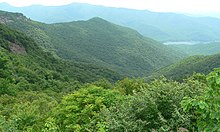|
North American Atlantic region  The North American Atlantic region is a floristic region within the Holarctic kingdom identified by Armen Takhtajan and Robert F. Thorne, spanning from the Atlantic and Gulf coasts to the Great Plains and comprising a major part of the United States and southeastern portions of Canada. It is bordered by the Circumboreal floristic region in the north, by the Rocky Mountain and Madrean floristic regions in the west and by the Caribbean floristic region of the Neotropical kingdom in the south of Florida. The flora of the region comprises two endemic monotypic families, Hydrastidaceae and Leitneriaceae, and is characterized by about a hundred of endemic genera (such as Sanguinaria, Leavenworthia, Gillenia, Neviusia, Dionaea, Yeatesia, Pleea). The degree of species endemism is very high, many species are Tertiary relicts, which survived the Wisconsin glaciation and are now concentrated in the Appalachians (esp. Blue Ridge Mountains) and the Ozarks. A number of genera (Sarracenia, Uvularia etc.) are shared only with the Canadian floristic province of the Circumboreal region. Moreover, as has long been noted (e.g. by Joseph Gerhard Zuccarini and especially by Asa Gray), a large number of relict genera (Liriodendron, Hamamelis, Stewartia etc.) are shared with the relatively distant Eastern Asiatic Region (comprising Japan, Korea, and the east of China) and sometimes Southeast Asia. R. F. Thorne counted at least 74 genera restricted to eastern North America and Asia (mostly eastern and southeastern Asia). The fossil record indicates that during the Tertiary period a warm temperate zone extended across much of the Northern Hemisphere, linking America to Asia. Subdivisions The North American Atlantic Region is subdivided further into three floristic provinces: the Appalachian Province, Atlantic and Gulf Coastal Plain Province, and North American Prairies province. Appalachian provinceThe Appalachian province comprises the upland eastern North America that was covered by deciduous forest in historic times, concentrated around the Appalachians and Ozarks, where its flora found refuge during Pleistocene glaciations. It stretches from southernmost Ontario and Quebec to Arkansas and easternmost Texas and from central Georgia and Alabama to eastern Iowa and southeastern Minnesota. The remaining wildland of the province is covered predominantly by temperate broadleaf and mixed forests dominated by oaks, hickories, maples and Tsuga and is characterized by the highest degree of endemism within the floristic region. It includes such ecoregions as the Appalachian mixed mesophytic forests, Appalachian-Blue Ridge forests and the Piedmont (as far east as the Fall Line).[1][2] Atlantic and Gulf Coastal Plain provinceThe Atlantic and Gulf Coastal Plain province is a strip of coastal plain, very narrow on the north, lying to the east and south of the Appalachian Province and stretching from the southernmost Nova Scotia through Georgia and Florida to eastern Texas, extending into the Mississippi Embayment up to the southern tip of Illinois. Due to Pleistocene inundations, most of its flora is much younger than that of the Appalachian province, but the degree of endemism is still high. The remaining wildland of the province is occupied mostly by temperate coniferous forests as well as temperate mixed forests dominated by pines (including such ecoregions as the Northeastern coastal forests, New England-Acadian forests, Atlantic coastal pine barrens). This province can be subdivided into smaller areas, most notably the gulf coastal plain and the Atlantic coastal plain.[3] North American Prairies provinceThe North American Prairies province is a large grassland floristic province lying between the Appalachian Province and the Rocky Mountains and including the prairies of the Great Plains. It is bounded by the Canadian coniferous forests on the north and the arid semideserts to the southwest. The province itself is occupied by temperate grasslands, savannas, and shrublands (including such ecoregions as the Flint Hills tall grasslands, Sand Hills, High Plains). Endemism is rather limited in this province, and its boundaries are vague. During the Pleistocene much of the province was glaciated. Endemic taxa
See alsoReferences
Bibliography
|